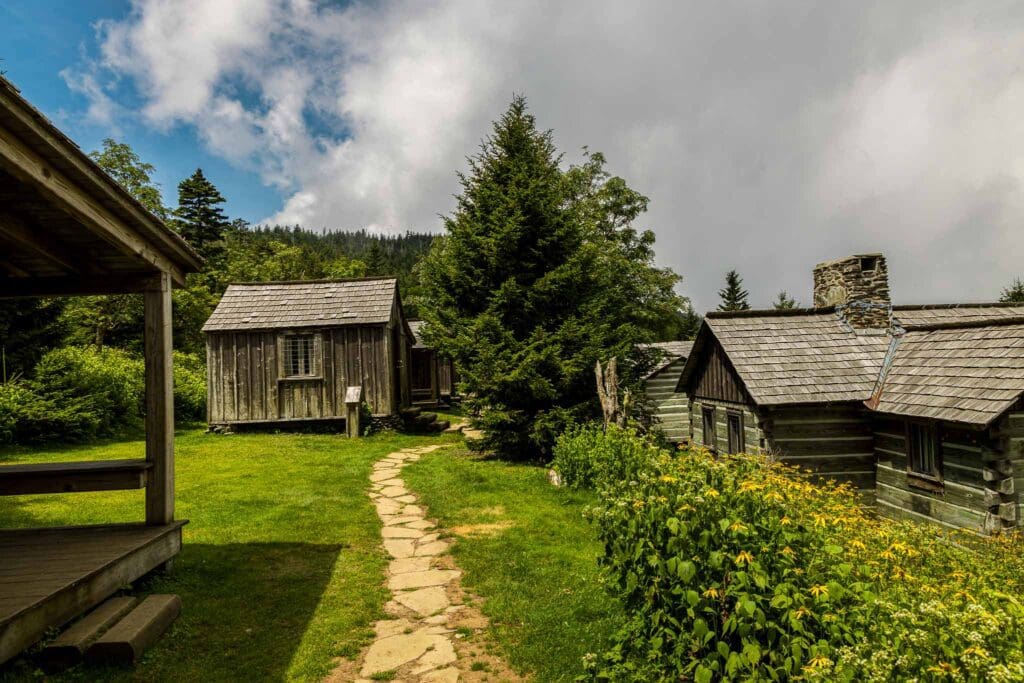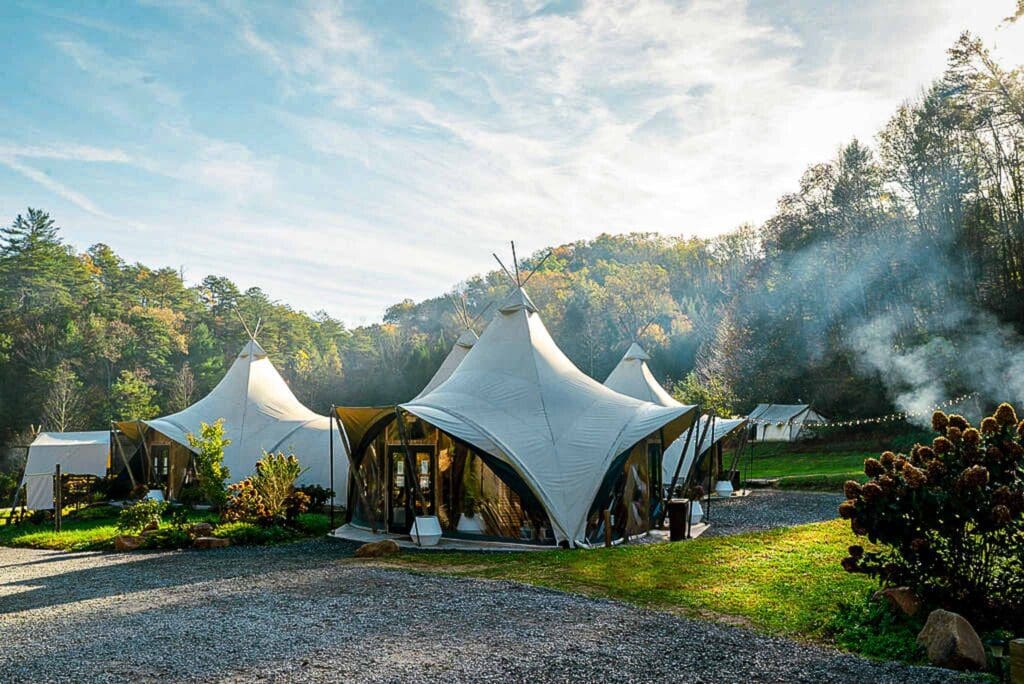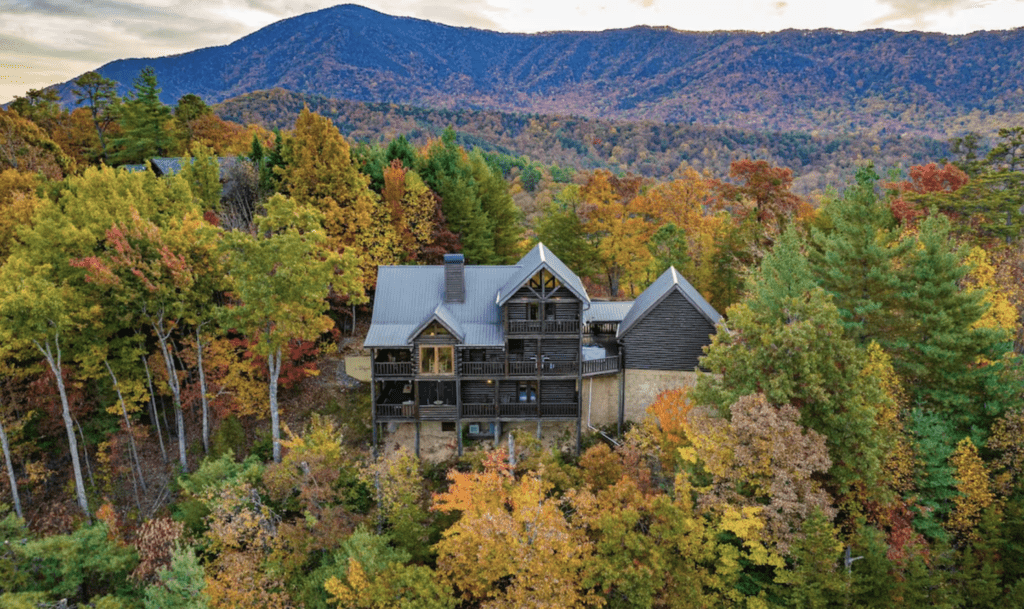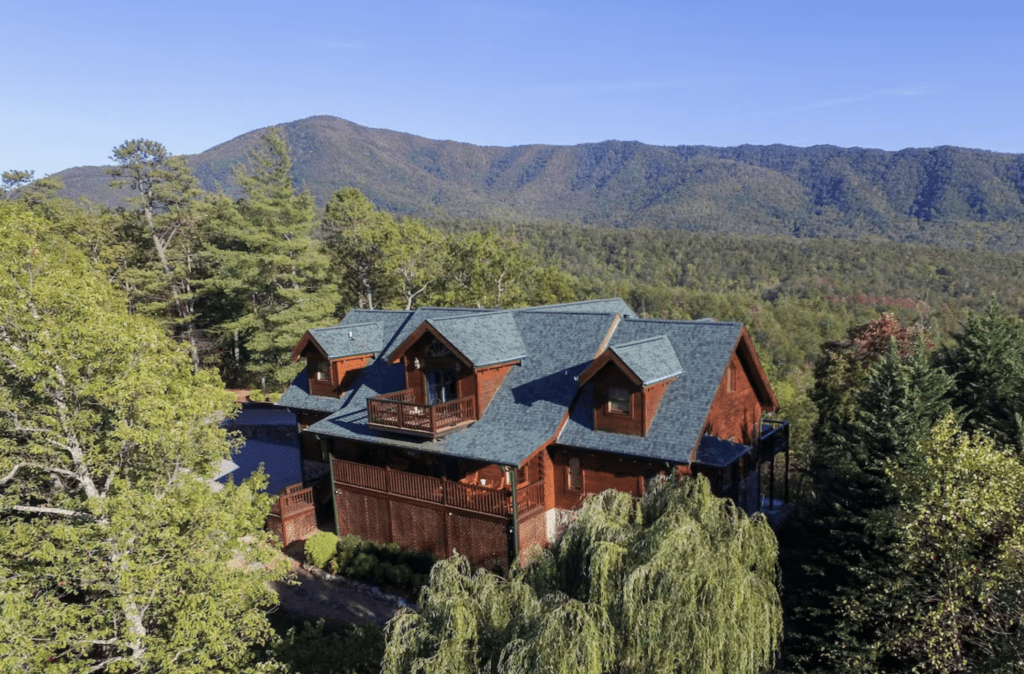|
Getting your Trinity Audio player ready...
|
Established 1934
Take some time to explore this extraordinary place, with its billowing mountains shrouded in mist, lushly green forests, and countless trails to explore. You’ll soon realize why it’s the most visited national park in the country.
Overview
The Great Smokey Mountains have earned their moniker from the enchanting misty blue-gray fog that surrounds them in the early hours. This mountain chain is among the most ancient on the planet. It even hindered and halted the Ice Age’s glaciers while they attempted to expand southward, creating a distinct line between southern and northern vegetation that is still noticeable today.
Peaks and ridges are topped with remarkable greenery alive with wildlife. In addition to the approximately 19,000 identified species of animals and plants, there are still plenty more that need to be documented. The national park’s woodland, half in Tennessee and half in North Carolina, is one of the oldest on Earth as well as the largest primal forest area in the eastern United States.
Many of these trees have been standing since before Europeans arrived in the southern Appalachians, and were even alive when the Cherokee referred to this area as the heart of their nation. They called it “Shalonage,” or “the place of the blue mist.”
Every year, over 14.1 million people flock into the Great Smoky Mountains National Park to witness its magnificent beauty, with its hazy and mesmerizing mountains.
The lure of hiking the Appalachian Trail entices those seeking a rigorous adventure, while scenic drives and historic sites beckon others to explore. The thick forests and diverse wildlife provide an unparalleled experience for all those who seek it.
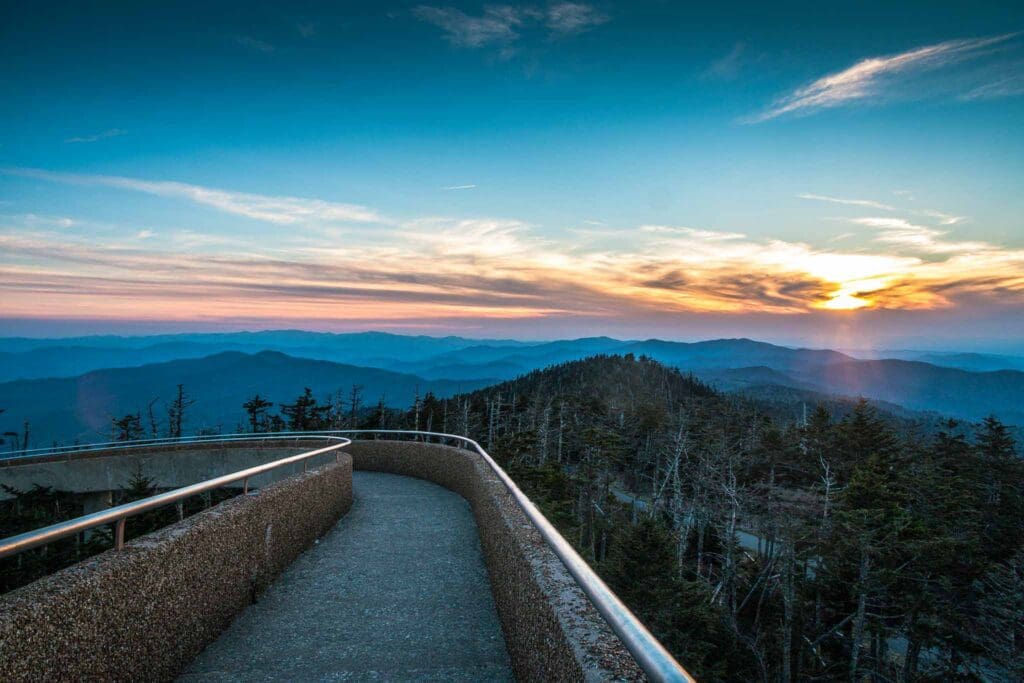
Clingman’s Dome Observation Tower is the premier place to go for taking pictures of the Great Smokey Mountains scenery. Photo by Simon Whitehurst/Adobe Stock.
Table of Contents:
Article Navigation: Click on any of the listed items in the table of contents below to jump to that section of the article. Similarly, clicking on any large, white section header will jump you back to the Table of Contents.
- Overview
- Human History
- Ecology and Biodiversity
- Geology
- Where To Stay
- Enjoying The Park
- Treat Yourself to a Guided Adventure
Human History
For centuries, a number of indigenous groups populated this area. The Cherokee Nation had long held their homeland here, occupying various towns nestled in the Appalachian Mountain valleys. Upon first meeting Europeans—mostly from colonial Virginia and the Carolinas—they served as traders. European Americans didn’t arrive to settle until much later, the late 1700s and early 1800s.
But then things changed quickly: In 1830 President Andrew Jackson signed the Indian Removal Act, launching the process that ended with all Native Americans east of the Mississippi River being driven to Indian Territory (now Oklahoma).
The majority of the Cherokee were relocated as well. Nevertheless, some, like Tsali, managed to hold out and stay in the current Great Smoky Mountains National Park area. A band on the Oconaluftee River also obtained territory and stayed in their homeland. Their progeny make up most of the acknowledged Eastern Band of Cherokee Indians that are headquartered in Cherokee, North Carolina. They have a reserve called Qualla Boundary located south of the park.
John Mingus and Ralph Hughes decided to settle on the Oconaluftee in 1795, and it was not long before other colonists joined them, beginning to clear away forestland and commence farming operations.
The first inhabitants of Cades Cove were John Oliver and his family, who relocated there in 1818, followed by a few more families like the Jobes, Gregorys, Sparkes, and Cables.
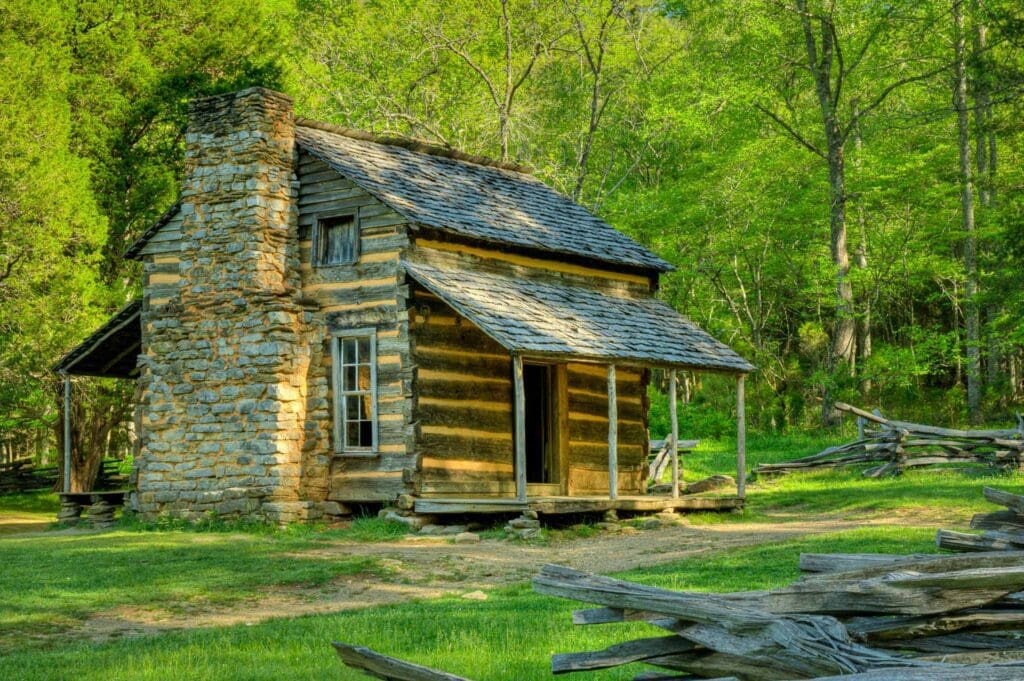
John Oliver’s Cabin at Cades Cove in Great Smoky Mountains National Park.
Eventually, the community was large enough that they could organize their own church in 1827—the Cades Cove Baptist Church.
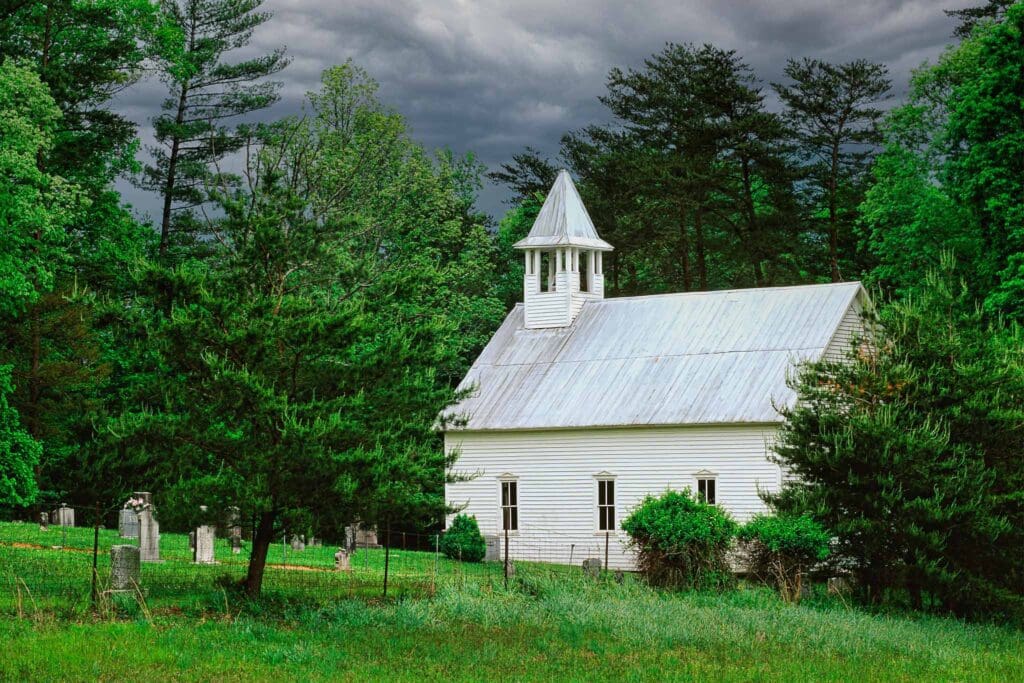
Cades Cove Baptist Church
As white settlers arrived, entrepreneurs developed logging in the mountains. The Little River Railroad was constructed to haul timber out of remote areas. This set an example for larger companies like Ritter Lumber Company and Montvale Timber Company who also purchased acres for logging. Champion purchased 92,000 acres, and by 1909 logging was at its peak. By 1920 over two-thirds of the Great Smoky Mountains National Park had been logged or burned.
Visitors and locals of the area joined forces to save it from clearcutting in the 20th century. The U.S. National Park Service wanted a park, but didn’t have enough funds.
David C. Chapman was appointed to head a commission in 1925, and Congress authorized a national park in 1926. John D. Rockefeller contributed $5 million, the government added $2 million, and citizens from TN & NC worked together to assemble the land for the park.
Mountain homesteaders and miners were evicted from the land to establish the protected areas of the Great Smoky Mountains National Park. Travel writer Horace Kephart and photographers Jim Thompson and George Masa were instrumental in its development. Ben W. Hooper was the main land purchasing agent, and it was officially established on June 15, 1934. During the Depression, federal organizations hired workers to improve infrastructure, including building trails, fire watchtowers, and other improvements to the park and Smoky Mountains.
Ecology and Biodiversity
The park is mainly wooded, with nearly 95 percent of the area covered in trees. About 187,000 acres—roughly 36 percent—are estimated to be old growth forests filled with trees that predate European colonization of the area. These ancient trees make up one of the most significant blocks of deciduous temperate forests in North America.
The park is rich in biodiversity, attributed to its many elevation levels, high volume of rainfall, and old growth forests. Around 19,000 species are known to inhabit the area while another 100,000 may not have been documented yet. Among the wildlife are 200 species of birds, 50 fish types, 39 reptiles, and 43 amphibians that include a variety of lungless salamanders.
The black bear population numbers around 1,500. The reintroduction of red wolves into the region in 1991 was unsuccessful and had to be removed by Fish & Wildlife Services in 1998. Elk (wapiti) were returned to the park three years later in 2001 at Cataloochee in the southeast corner.
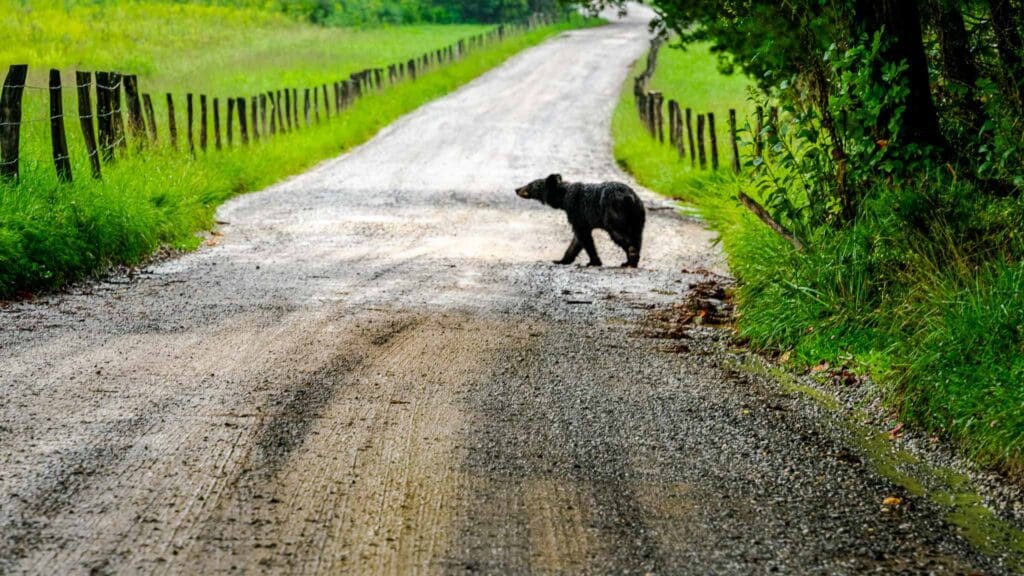
Black Bear crossing a road at Cades Cove in Great Smokey Mountains National Park.
The park is home to a variety of mammals, such as raccoons, bobcats, foxes, river otters, woodchucks, beavers, squirrels, opossums, coyotes, white-tailed deer, chipmunks, skunks and different types of bats. There are more than 100 species of trees in the park. The lowlands tend to have deciduous leafy trees while higher up you’ll find coniferous trees like Fraser fir. In addition, there are over 1,400 flowering plant species and around 4,000 non-flowering plants.
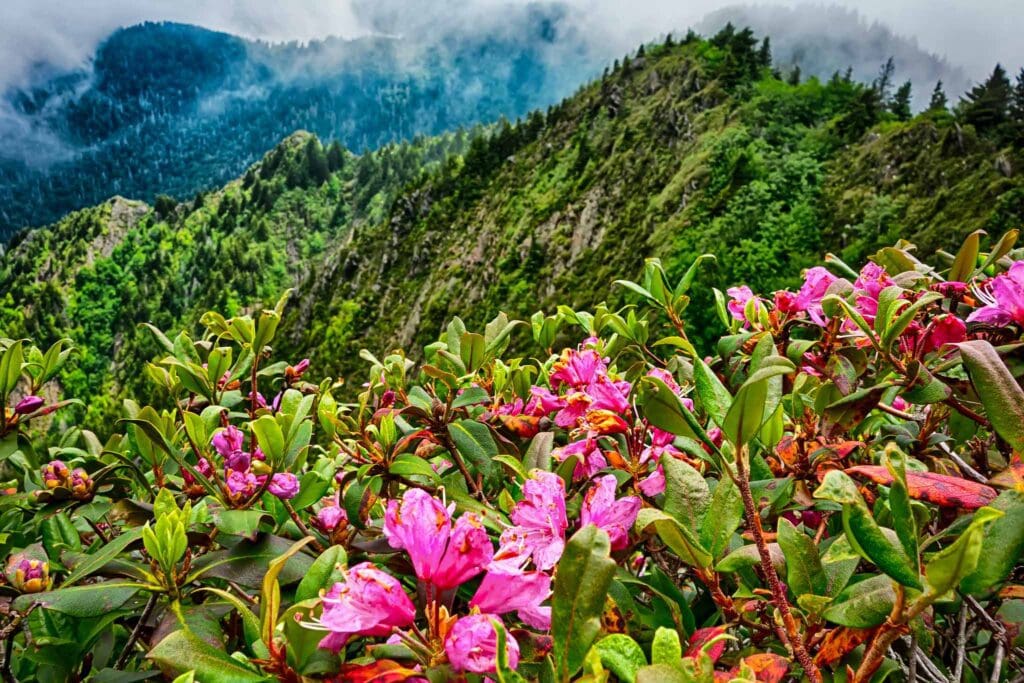
Scenes along Appalachian Trail in the Great Smokey Mountains.
At over 522,419 acres, the park is one of the largest intact forest ecosystems in the southern Appalachian mountains, and contains one of the largest blocks of deciduous, temperate, old growth forests remaining in North America. Over 90% of the property is managed for wilderness values. The park adjoins several national forests on parts of its boundary, providing some additional protection and connectivity to the larger landscape.
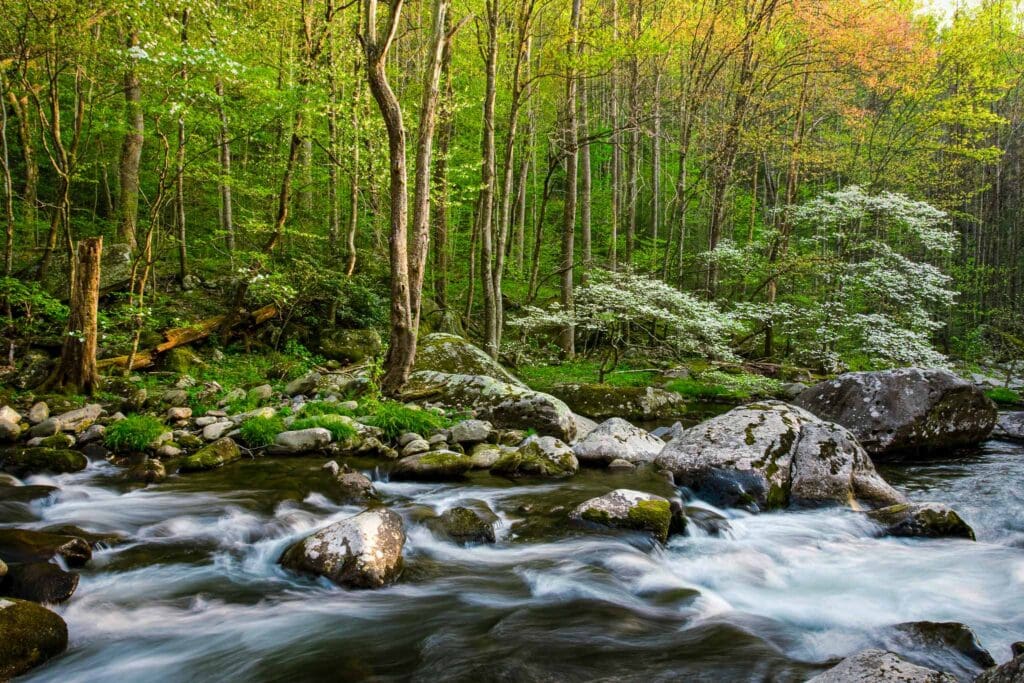
Dogwood trees in spring along Middle Prong Little River near Tremont in Great Smoky Mountains National Park. Photo by Richard & Susan Day/Danita Delimont/Adobe Stock.
The Great Smoky Mountains is one of the most ecologically rich and diverse temperate zone protected areas in the world. There are over 1300 native vascular plant species, including 105 native tree species, plus nearly 500 species of non-vascular plants – a level of floristic diversity that rivals or exceeds other temperate zone protected areas of similar size. The park is also home to the world’s greatest diversity of salamander species (31) – an important indicator of overall ecosystem health – and is the center of diversity for lungless salamanders, with 24 species.
Because of its remarkable biodiversity, Great Smoky Mountains National Park was designated an International Biosphere Reserve in 1976, a UNESCO World Heritage Site in 1983 and and became a part of the Southern Appalachian Man and the Biosphere (SAMAB) reserve in 1988. No other area of similar size and climate has as many documented species of plants, animals and invertebrates.
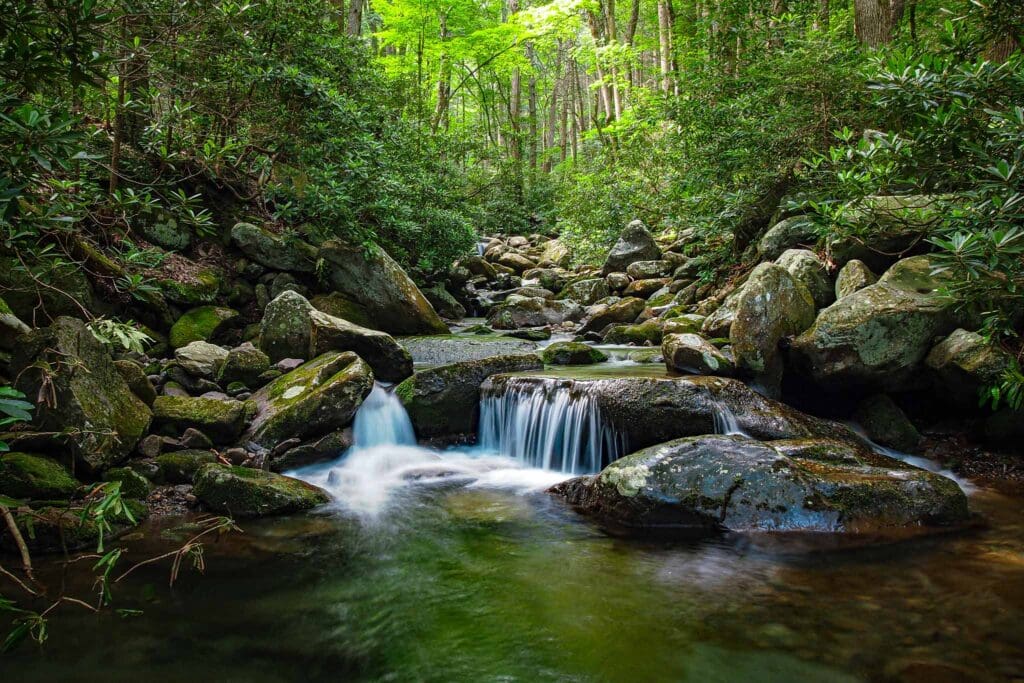
Trailside creek in the Great Smoky Mountains National Park in early summer.
Geology
The Great Smoky Mountains National Park is mainly composed of Late Precambrian Ocoee Supergroup rocks, which consists of metamorphosed sandstones, phyllites, schists, and slate. Early Precambrian rocks are the oldest rocks in the park and dominate some areas such as Raven Fork Valley and upper Tuckasegee River between Cherokee and Bryson City, primarily consisting of gneiss, granite, and schist.
Further north, near the foothills, lies sedimentary Cambrian-age rocks. Cades Cove is a prime example here, with its limestone coves tucked into sandstone valley floors. This geological diversity makes Cades Cove one of the most visited attractions in the mountains.
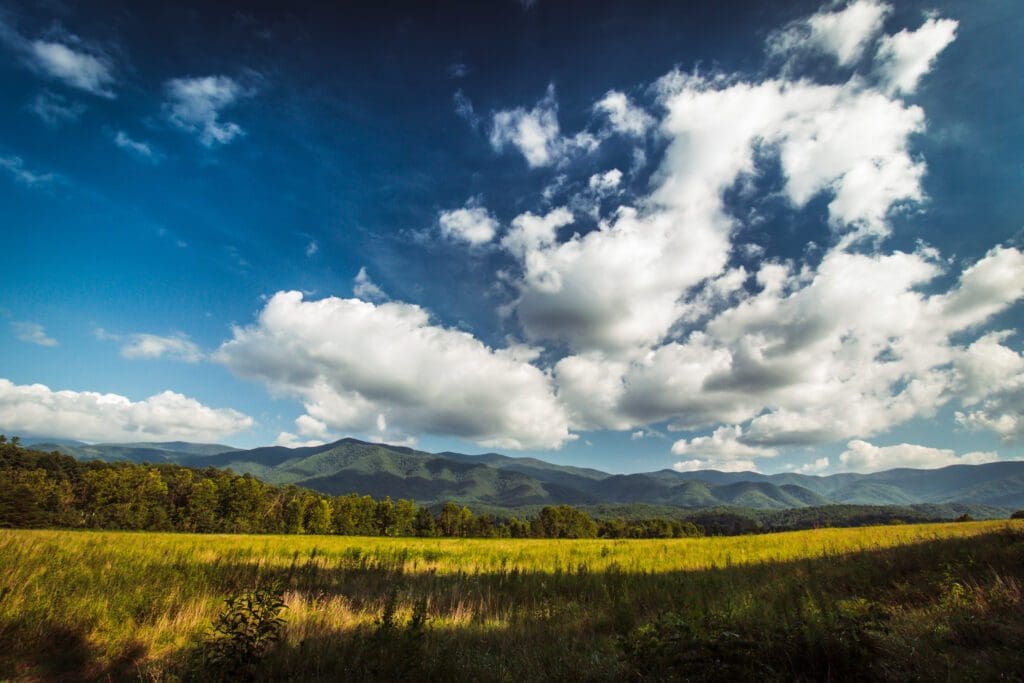
Curves of Cades Cove in Great Smokey Mountains National Park
The oldest rocks in the Smokies, formed over a billion years ago, are gneiss and schists that were created from the collection of marine particles and igneous material. The Ocoee Supergroup was formed when the primordial ocean advanced and sedimentary rock settled on the continental shelf. During the Paleozoic Era, a thick layer of marine sediments was left behind from the oceans’ movements.
The Alleghanian orogeny began approximately 325 million years ago and ended about 260 million years ago, involving five deformation events during the Carboniferous and Permian eras. This mountain-forming event was caused when Africa collided with North America, which at that time were part of two distinct supercontinents: Euramerica and Gondwana. As a result of this collision, the continents fused together to form the giant landmass Pangaea. This collision caused immense stress on the Eastern Seaboard.

Graphic of the land mass of the supercontinent Pangea.
The collision triggered orogeny, a tremendous force that eventually shaped the Eastern Seaboard of North America into a large and lofty mountain range. Signatures of the Alleghanian orogeny can be seen along hundreds of miles, from Alabama to New Jersey, and from subsurface rocks to the southwest and northeast up to Newfoundland.
The mountain range that was formed by the Alleghanian orogeny was tall and grand during the Mesozoic and late Paleozoic eras, but erosion has worn them down to just a few hills in the present-day Piedmont region. Materials that were carried eastward produced the coastal plain and part of the continental shelf. All of these areas are mainly composed of eroded sediment from more than 150 million years ago up until now. And, while people living near Allegheny and Cumberland plateaux often refer to them as mountains, they are actually uplifted plateaux that have been slowly eroded over time.
Good To Know: Orogeny is the process of mountain building that happens when two landmasses collide. This could be continental crusts coming together (continent-continent collision) or the boundary between oceanic and continental crust meeting (ocean-continent collision).
A chunk of the Alleghanian mountain range was left behind when Africa moved away from Pangaea and the Atlantic Ocean started to form. This section is now known as the Anti-Atlas mountains in Morocco. These mountains have been raised by geological forces quite recently, making them much more rugged compared to their counterparts in America.
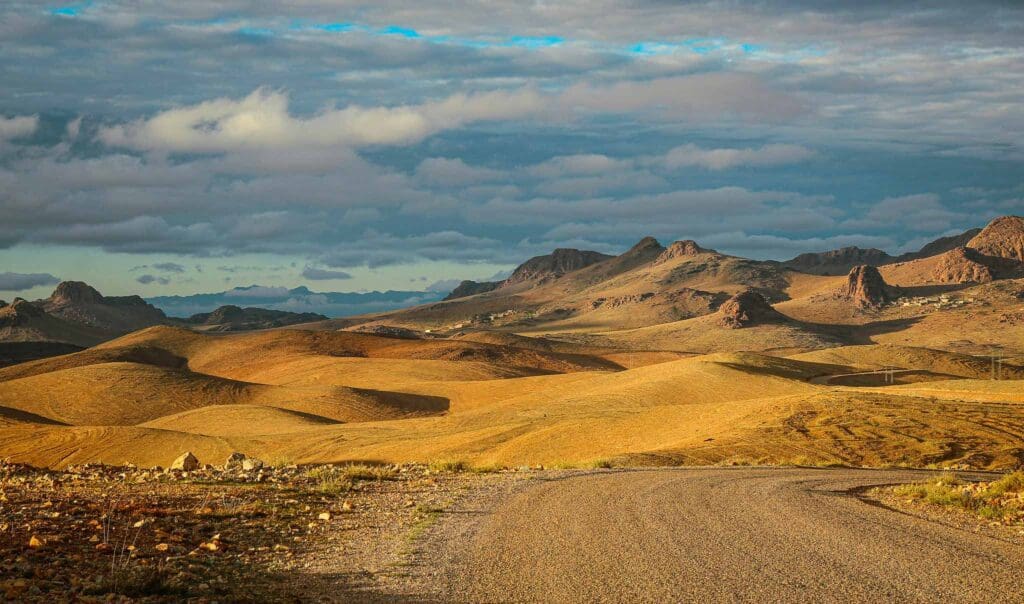
Part of the Alleghanian mountain system seceded with Africa to form the Anti-Atlas mountains of Morocco.
Where To Stay
If you’re ready to experience the Smokies, you’ll need a plan for visiting the national park. This guide will provide insight on the best places to stay in the Smokey Mountains, as well as details about the areas and inspiration for your destination.
You won’t find any motels or cabins within the boundaries of the national park, but if you look outside the park’s limits, you’ll find a plethora of lodging options. Hotels, cabins, bed and breakfasts, and campgrounds all await you in the nearby towns.
Campgrounds
If you’re looking to stay overnight in Great Smoky Mountains National Park, there are 10 developed frontcountry campgrounds available for your use. Follow the links below for more information about each campground.
- Abrams Creek Campground
- Balsam Mountain Campground
- Big Creek Campground
- Cades Cove Campground
- Cataloochee Campground
- Cosby Campground
- Deep Creek Campground
- Elkmont Campground
- Look Rock Campground
- Smokemont Campground
Camping is only allowed in the designated areas, not in parking lots or pull-outs. Camping in the park is popular all year round and there are plenty of options to choose from; Cades Cove and Smokemont Campgrounds are open throughout the year while other campgrounds are seasonal. Every campsite has a fire grate and picnic table but no electrical, water or shower hookups; however, showers can be found nearby. When you check-in at the campground, inquire about the closest shower facilities.
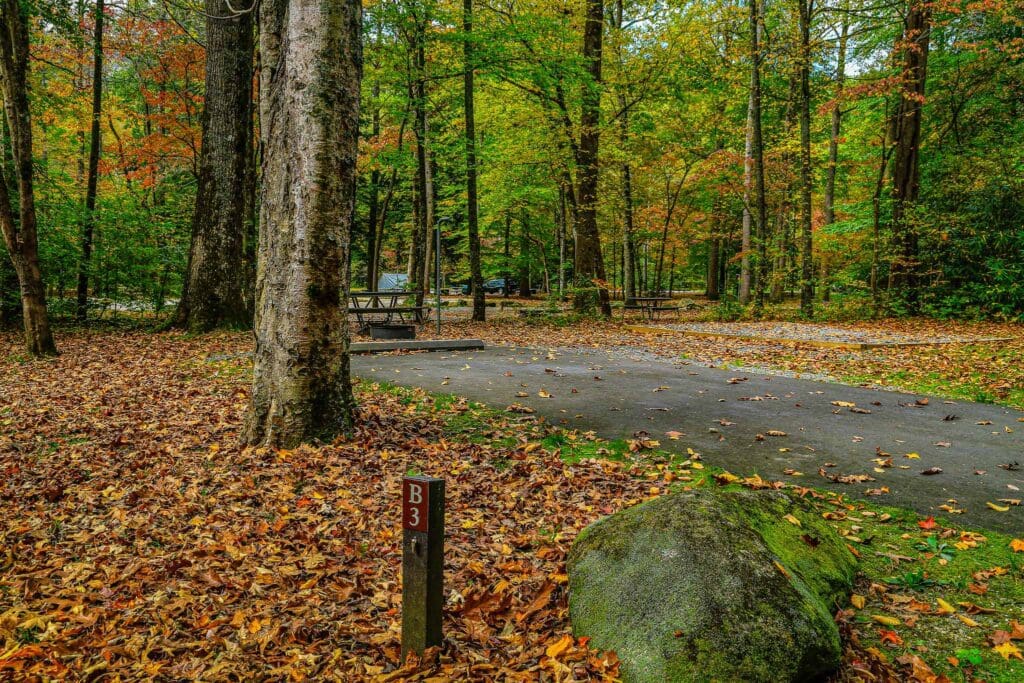
Smokemont Campground in Great Smoky Mountains National Park.
Leconte Lodge
The park’s third highest peak is Mount Le Conte which stands at 6,593 feet (2,010 m). The Alum Cave Trail is the favored way to the summit of Mount Le Conte and features several scenic overlooks and special places, such as Alum Cave Bluffs and Arch Rock. As one of the most popular spots in the park, this peak draws many visitors each year.
Hikers can even stay overnight at the LeConte Lodge near the peak which provides cabins or available rooms (except during winter). It is the only private accommodation within the park that can only be accessed by a trail. Five trails lead there, ranging from 5.0 to 9.1 miles.
All supplies are brought in on llamas, which can be seen making their way up Trillium Gap a few mornings during the week. Guests enjoy dinner by kerosene lamps and then retreat to bunks for the quiet Appalachian night.
The electricity-free Lodge provides a peaceful and simple atmosphere, where guests can relax in the cool solitude of the Smokies. Guests stay in hand built log cabins with basic amenities. Meals are served family style in the dining room.
Book your stay!
Upscale Glamping at Under Canvas
Spend a night in the “Land of Blue Smoke” at Under Canvas Great Smokey Mountains in nearby Sevierville, Tennessee. Live the dream and enjoy the grandeur of the Great Smokey Mountain range from one of their upscale, safari-style tents. Each tent includes a king-size bed with comfortable linens, private bathroom with hot showers, wood burning stoves, plus stunning views of the verdant mountains.
Under Canvas offers wholesome and delicious café-style dining on-site, which can be enjoyed inside or out. Enjoy a leisurely breakfast in camp with a Bluestone Lane espresso drink to fuel your day’s adventure. For dinner, dine al fresco on a patio surrounded by lush greenery and towering trees. Under Canvas Great Smokey Mountains also offers plenty of Grab N Go provisions available for purchase, including pre-packaged bites and dry snacks prepared daily for a day of adventure.
Book your stay at Expedia
Rent A Cabin or House with VRBO
When hotels are booked, your next best option is VRBO. If you don’t know already, VRBO is a service that lets homeowners rent out their properties for tourists to use seasonally. So, particularly if you plan on coming to the Smokey’s in the off-season, you can find some killer lodging just outside the park for cheap! We dug up a few that would make for prime real estate for an off-season climbing adventure. Here are Vrbo’s top 50 cabins near the park.
The following are just a couple of our favorite cabins near the park.
Park Edge Lodge
Enjoying The Park
If this is your maiden voyage to the Great Smoky Mountains National Park, there are a few sites that you just can’t miss. And if you’ve been here before, it might be worth revisiting these attractions!
Landscape Viewing at Climgman’s Dome
At 6,643-feet (2,025-meters) tall, foggy Clingman’s Dome stands as the highest peak in the Smokey Mountains. A car ride followed by a brief 0.5-mile (0.8-km) hike will lead you to an observation tower that looks like something from outer space. If you’re lucky enough to visit on a clear day, you can see over one hundred miles (161-km) and across seven states from atop the panoramic platform. Sunset viewing here is especially beautiful, with wispy clouds painting the sky pink and purple. Come fall, the view of the gold and red mountains is absolutely remarkable.

The moon shines over the Climgman’s Dome Observation Tower.
Autumn Scenic Drives
Take in the bright oranges, yellows, and reds of fall on one of the suggested scenic drives listed below:
Roaring Fork Motor Nature Trail
Begin your journey on Roaring Fork Motor Nature Trail from the Parkway in downtown Gatlinburg; turn right at stoplight #8 onto Historic Nature Trail – Airport Road, then straight at the intersection and continue into Great Smoky Mountains National Park.
A brief detour to the Noah “Bud” Ogle historic area allows you to take a self-guided tour of the mountain farm along with some local flora and fauna. Following that, take the narrow, steep, winding road through dense forests next to Roaring Fork Creek. To get the best views, enjoy leisurely travel at stop #3 and go for a short stroll down the path to find a viewpoint lined with benches waiting for you to relax and soak in the scenery.
Stop #5 offers a moderate 2.6 mile round-trip hike through old-growth forest leading you to Grotto Falls. As well as the abundance of nature spots, there are several historic buildings like the Reagan tub mill close enough so it almost feels like you’re driving through it!
Don’t forget Place of a Thousand Drips waterfall which becomes remarkable after rainfall. Finally return to Gatlinburg via US-321.
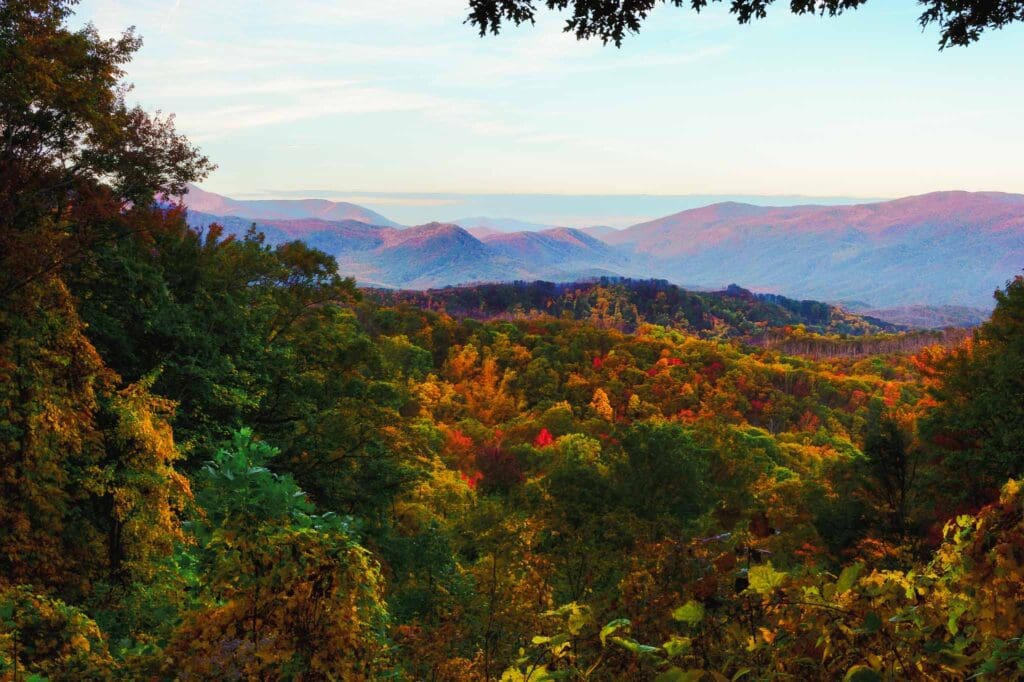
Roaring Fork Motor Trail located in the Smokey Mountains is a 5-mile long single lane road with cabins, creeks, and vast landscapes filled with autumn colors.
Blue Ridge Parkway
Harness the beauty of the Blue Ridge Parkway, beginning near the entrance to Great Smokey Mountains National Park on US 441 in Cherokee, North Carolina. For an incredible 469 miles, the parkway follows the ridge of the mountains until you reach Shenandoah National Park in Virginia. Numerous pullouts can be found along the first few miles of the road and offer beautiful views of the Smokey Mountains during their blazing autumn season.
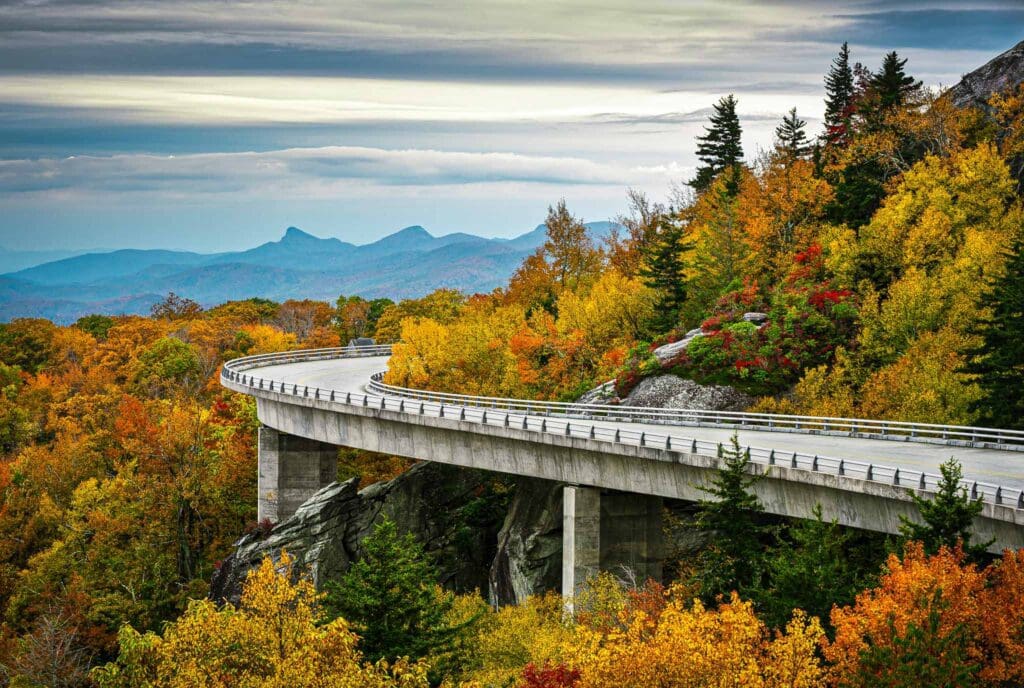
Blue Ridge Parkway in autumn at the Linn Cove Viaduct with views of Grandfather Mountain in western North Carolina.
Best Hiking Trails
Great Smokey Mountains National Park offers hikers 850 miles (1,370 km) of trails and unpaved roads, with 70 miles (110 km) of the Appalachian Trail. Here are a few of our favorites.
Appalachian Trail: To hike the Appalachian Trail, start at the large parking area near Newfound Gap. Once you’ve crossed the road to get to the trailhead, look for a sign marking where it begins. Follow the path until you reach Indian Gap, which is located on Clingmans Dome Road. It’s a 6.8-mile roundtrip journey to and from Indian Gap.
Inspiration Point on Alum Cave Trail: For your journey to Inspiration Point on Alum Cave Trail, start at the Alum Cave Trail parking area, located 10.5 miles south of Gatlinburg and along Newfound Gap Road (Highway US-441). The one-way hike is 1.8 miles long and will take you through a beautiful old-growth forest before closing with spectacular views of the mountainsides.
Oconaluftee River Trail: Drive to Oconaluftee Visitor Center and park in the designated spot. Take the path that starts close to the entrance of the historic building area, and follow it along the banks of the Oconaluftee River for 1.5 miles until you reach Cherokee, North Carolina.
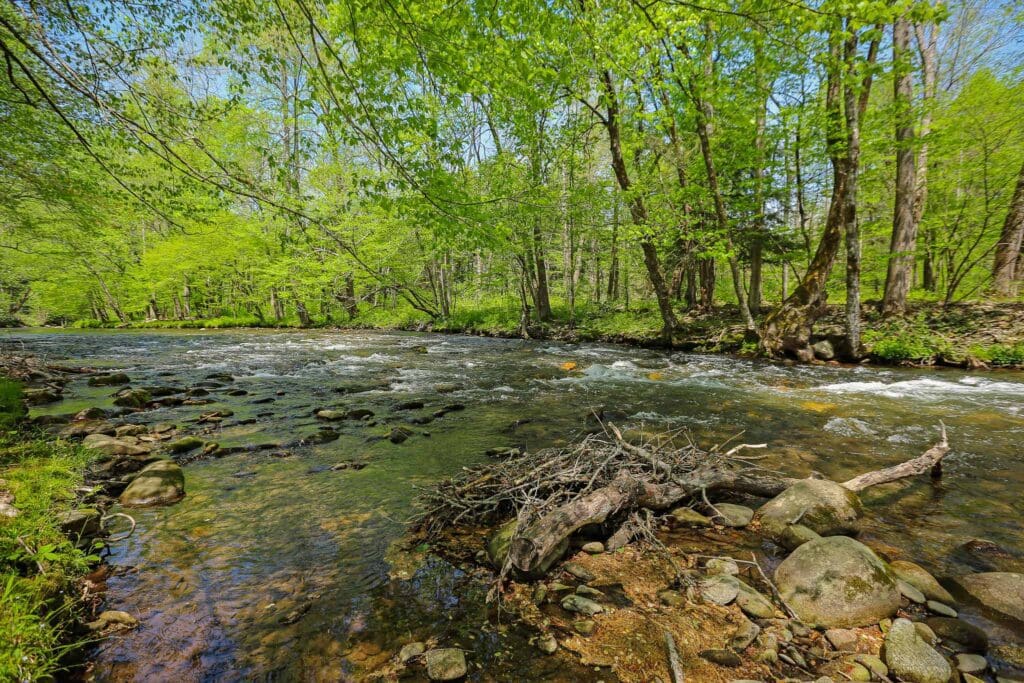
Oconaluftee River Trail.
Look Rock Tower: Start your journey out of Townsend, TN, heading north on US-321 until you reach the Foothills Parkway. Take this scenic route to the Look Rock parking area, and from there, the moderate 1-mile roundtrip hike will lead you to the tower. Make sure to take in all of the amazing views as you reach the top!
Sutton Ridge Overlook: When you arrive, park in the designated hiker parking lot located right before Cosby Campground. Take the Cosby Self-guiding Nature Trail until you reach the start of Lower Mount Cammerer Trail, then keep on the path until it forks off into a 200-yard spur trail to get to the overlook. The total length of the expedition is 1.4 miles.
Alum Cave Trail: Also known as the Alum Cave Bluff Trail is a popular trail that climbs Mount Le Conte, one of the highest peaks to the east of the Mississippi River. If you are determined to reach the summit, the Alum Cave Trail is a demanding 11-mile path that has an ascent of 3,061 feet. Along the way, it passes various famous spots such as Arch Rock, Inspiration Point, Duckhawk Peaks, and Cliff Top, eventually merging with Rainbow Falls Trail at the top.
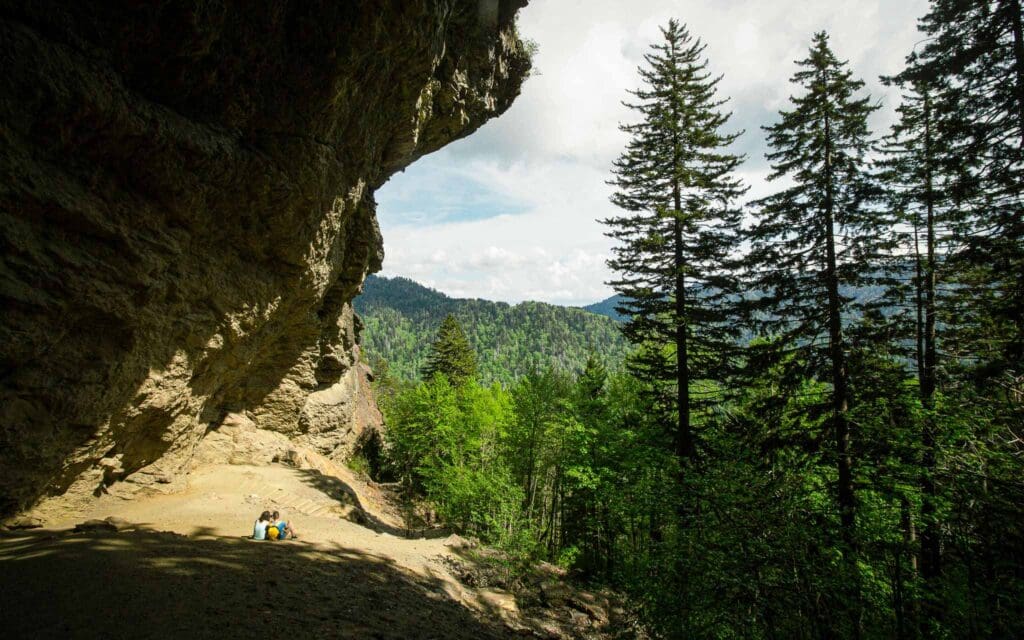
Alum Cave Bluff. Photo by Theron Stripling III/Adobe Stock.
Laurel Falls Trail: This 2.6-mile, round-trip hike begins with a gradual incline through oaks and mountain laurel, leading to the stunning 80-foot Laurel Falls spilling down into two inviting pools for wading.
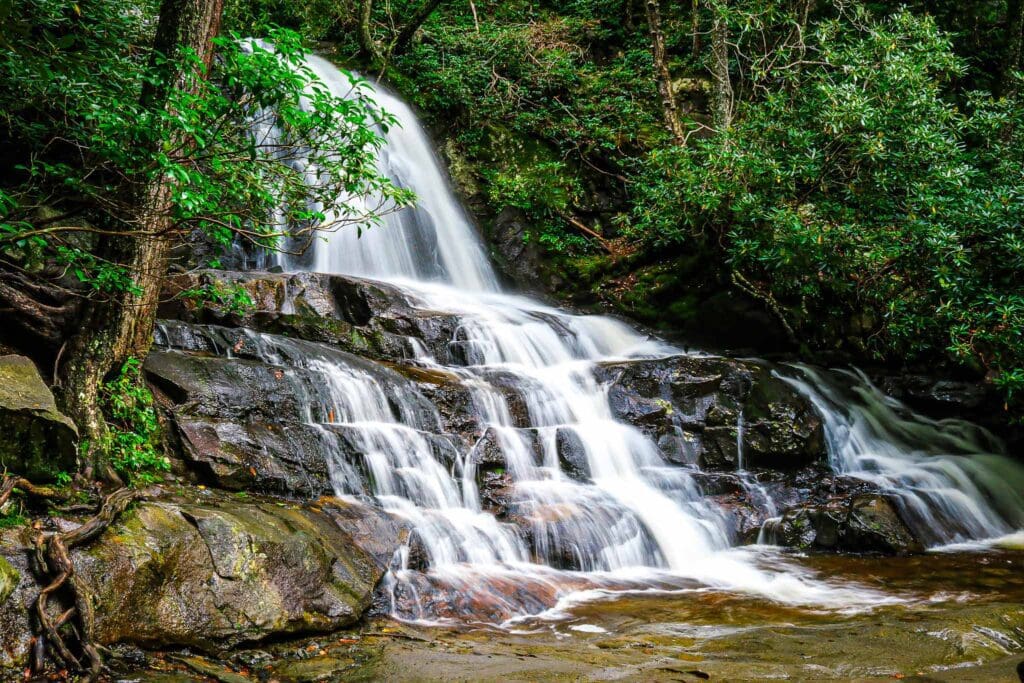
Laurel Falls in the Great Smokey Mountain National Park.
Chimney Tops: This 3.5-mile out-and-back trek is considered a difficult one, given the 1,400-ft. elevation gain. Ascending steeply through an abundance of rhododendrons and winding across various streams, the quad burner arrives at two knobs made up of metamorphic rock, famously referred to as “the chimneys.”
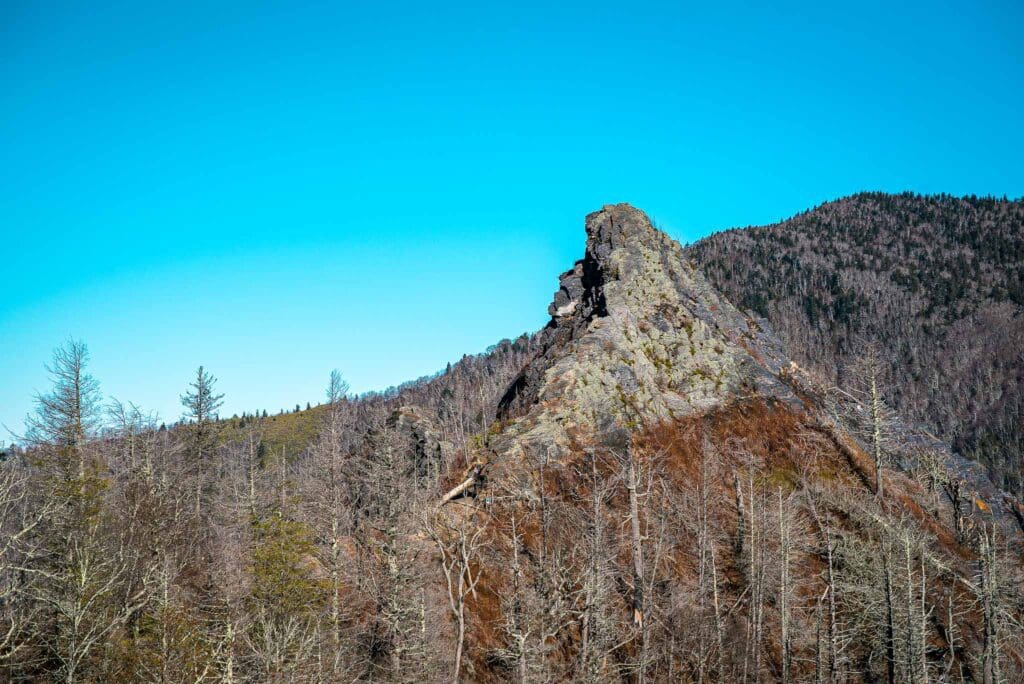
Chimney Tops
Rainbow Falls Trail: This difficult 5.1-mile out-and-back trek features a 1,700-ft elevation gain with rocky sections and switchbacks. It follows LeConte Creek and passes areas of rosebay rhododendron, teaberry, mountain pepper-bush and pink lady’s slippers. At two miles, a log footbridge crosses the creek, and at four miles an 80 ft waterfall appears which freezes into an hourglass shape during winter.
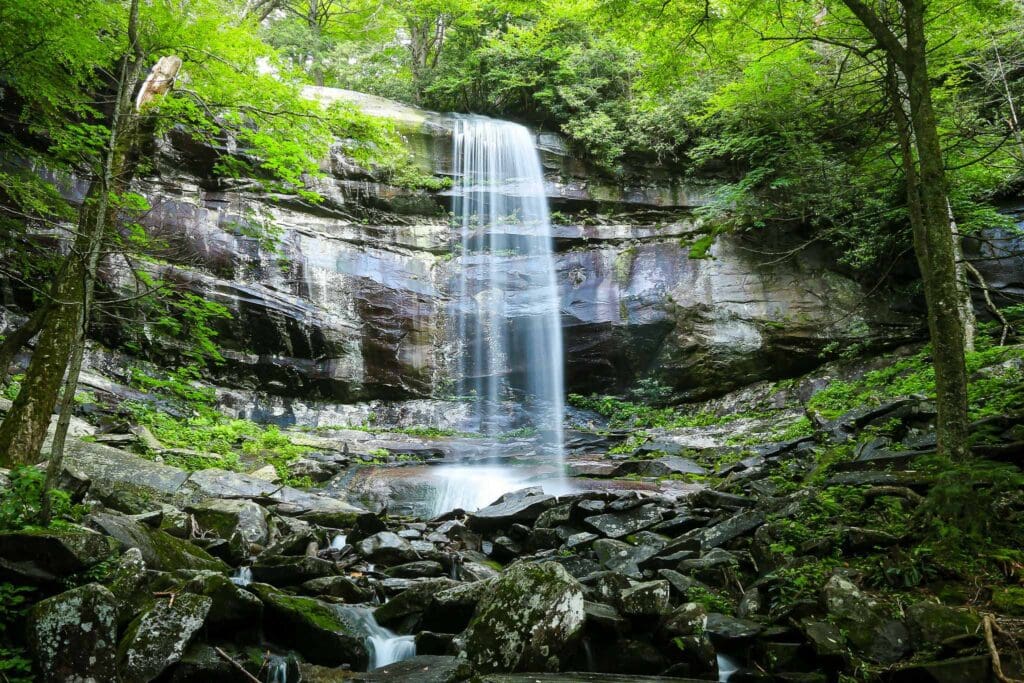
Rainbow Falls, Great Smoky Mountains National Park.
Backpacking
In addition to day hiking, the national park also offers backpacking opportunities. Camping is only allowed in dedicated spots and shelters. The majority of the park’s shelters lie alongside the Appalachian Trail or a short distance away on side trails.
However, there are three other shelters that are not situated on the Appalachian Trail. The Mt. LeConte Shelter is located close to LeConte Lodge on The Boulevard Trail and can fit up to 12 people per night. Keep in mind, campfires are strictly prohibited at this location.
The Kephart Shelter is located near the end of the Kephart Prong Trail which starts upstream of Collins Creek Picnic Area; it can accommodate 14 individuals.
Laurel Gap Shelter is one of the more isolated places in the park and it lies between Balsam High Top and Big Cataloochee Mountain—up to 14 people can spend the night here. This shelter is a preferred base for those who want to explore the Smokies wilderness.
The backcountry campsites are situated across the park, a beacon of hope for travelers looking to explore the vast wilderness. To camp in these sites, it is mandatory to obtain a permit either at the ranger stations or through the park’s website. Moreover, reservations must be made for both shelters and backcountry campsites. The duration of your stay is limited based on where you camp, with a maximum of one night for shelters and three nights for campsites.
Cycling
While bicycles are allowed to go on most of the roads within the park, many of them may not be ideal for biking due to their steepness, tight spaces, and high levels of auto traffic. This makes it difficult to ensure safe and enjoyable rides.
The Cades Cove Loop Road stands out from other roads. Spanning 11 miles and allowing only one-way traffic, it is a favorite destination for cyclists. Here they can take in the sights of 19th century homesteads while watching out for wildlife. To provide even greater access to pedestrians and bikers, motor vehicles are prohibited from traveling down this road all day on Wednesdays between May and the end of September. During the warmer months, bikes are available for rent near the campground store located next to Cades Cove Campground.
Treat Yourself To A Guided Adventure
If you’re looking to explore a new activity or deepen your mastery of an existing sport, it pays to invest in a professional. Guides not only ensure your safety when doing something for the first time, but they can also lead you off the beaten path and offer enlightening details about history, culture and geology. Plus, prepare yourself for captivating narratives no one else can tell. To hire an experienced local pro, you can use services such as 57Hours or REI Adventures.

Journey beyond the national park and backpack the Appalachian Mountains in this unique, 4-day hike among diverse landscapes. Photo courtesy of REI.
Book a one-of-a-kind journey with REI Adventures in the Great Smoky Mountains. The American Classic National Park is waiting for you! Enjoy an excursion with REI’s fully-guided tour in the Smokies: hiking, backpacking, river rafting, zip lining and more thrills await you.
When a travel emergency arises, traditional travel insurance may not come to your aid, and a medical evacuation can cost up to $300,000.
The cost when you have a Global Rescue membership? $0. That’s why when the unexpected happens, you want the leader in rescue, evacuation and medical advisory behind you. You want Global Rescue.





